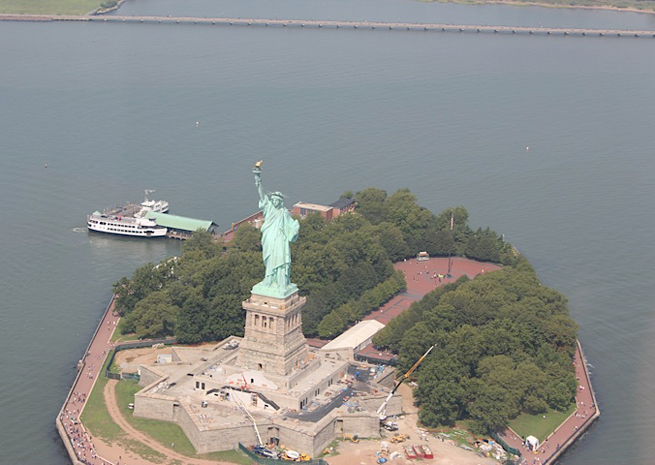
One of the best things about flying is taking friends for sight seeing flights. Living in the Northeast, New York City offers one of the most scenic trips you can take, and one of the most challenging.
The combination made for a perfect event for the East Hill Flying Club based at Ithaca Tompkins Regional Airport (KITH) in upstate New York. The club decided to host a “Freedom Flight” down the Hudson River Corridor on Memorial Day Weekend to honor the men and women who fought and died for the freedoms we enjoy today, including our freedom to fly.
The airspace around New York City is the busiest in the nation and after a midair collision in 2009, the FAA created a Special Flight Rules Area (SFRA) for the Hudson River Corridor. Before embarking on the popular sight seeing flight, pilots are required to take an FAA online course and short test.
The course outlines the three tiers of airspace—the Skyline Route, which is a Class B VFR transition above 1,300’ MSL; Transient Operations between 1,000’ MSL and up to but not including 1,300’ MSL; or Local Operations from the surface up to but not including 1,000’ MSL, which is mostly for helicopters or other aircraft making frequent altitude or directional changes.
ATC clearance is required for the Skyline Route and the East River Exclusion, while mandatory reporting at seven specific points along the Hudson between the Verrazano Bridge on the south end of the corridor and the Alpine Tower north of the George Washington Bridge (also a reporting point) is all that is needed for Transient or Local operations.
Working With ATC
The first thing EHFC did was post the event on its Facebook page to encourage members to participate. Club President David St. George then called New York Center and arranged a route.
“They’re very cooperative. Usually they let you come up the East River and then over the center of Manhattan north of Central Park, which is pretty special. You see a lot more,” he said. The plan was to depart Ithaca and fly with a 2-mile separation en trail at 2,500 feet.
“They work you as separate N-numbers. Everyone has a squawk leaving Ithaca. Our tower is very cooperative so they were ready to hand out flight following for everybody,” David said. “It’s very hard to acquire it down there [near the Hudson River Corridor], especially if they’re very busy and you show up with 10 planes.”
The next thing the club did was host a ground school. “We viewed the course, talked about the airspace and what was expected. Then we took the iPad and showed the route,” David said. “I think one of the critical things is to pair up a more experience person with one that’s a beginner so when they’re in the cockpit there’s no chance of somebody screwing up.”
The aircraft and crews were listed on a white board at the flying club. Four of the eight planes scheduled to participate were club aircraft, while the others were members who own their own planes. The morning of the flight was going to be a final briefing and any adjustments to crews if needed.
Four of the pilots would have been flying the corridor for the first time, while the other four have done it before. East Hill has made the trip—once before 9/11 at night, and a twice since then. David said the club tries to do it every few years.
“The key is to do it enough so people anticipate the next one,” he said. “When is the next corridor trip becomes a big thing and that fuels interest in participating or trying it on their own.”
Master’s Course for Pilots
EHFC has developed a set of steps and a mentoring culture to continue a pilot’s development after someone earns a private pilot certificate. “Otherwise you’re on your own exploring, figuring it out and that’s not always the safe way to do it,” David said. “It’s much better to have an articulated, mentored way of growing your experience and that’s what a club is good for.”
The first step is to go to busier airspace, like a class Charlie, land and come back. For EHFC it’s generally somewhere like Syracuse or Rochester. Step two is usually an overnight trip to Block Island, Providence, Rhode Island, or Boston. From there, it’s a little longer trip, perhaps a three-day, three-leg trip. These flights give pilots experience with flight planning and weather, communicating with ATC, and often lead to pilots going on to earn their IFR ratings.
“For some of these people it’s a challenge. But we’ve almost worked it up into a master’s course for pilots,” David said. “After you get your certificate you’re not ready to challenge the whole country, at least most people aren’t. So you’ve got to build it in steps.”
The stepped approached helps increase the club’s business (EHFC is also a part 141 flight school), as well as member flying. “We’ve found that it’s very valuable to take them the next step,” David said. “That’s what clubs do, we help people move to that next step.”
Unfortunately low ceilings and high winds kept the Freedom Flight on the ground this Memorial Day. However, two pilots did make the trip on their own, including one who had never flown down the Hudson before. “Just putting it out there empowers people,” David said. “They did the training and they want to do this. It’s challenging enough, but not too intimidating. People can actually do it.”
East Hill Flying Club is planning to do the trip to celebrate the 4th of July. “The idea of a Freedom Flight and July 4th work out pretty well,” David said. “This vision is to get a sizable turnout for this. I don’t want to say 20 planes, but can you imagine how powerful that would be to have that number of people going down.”